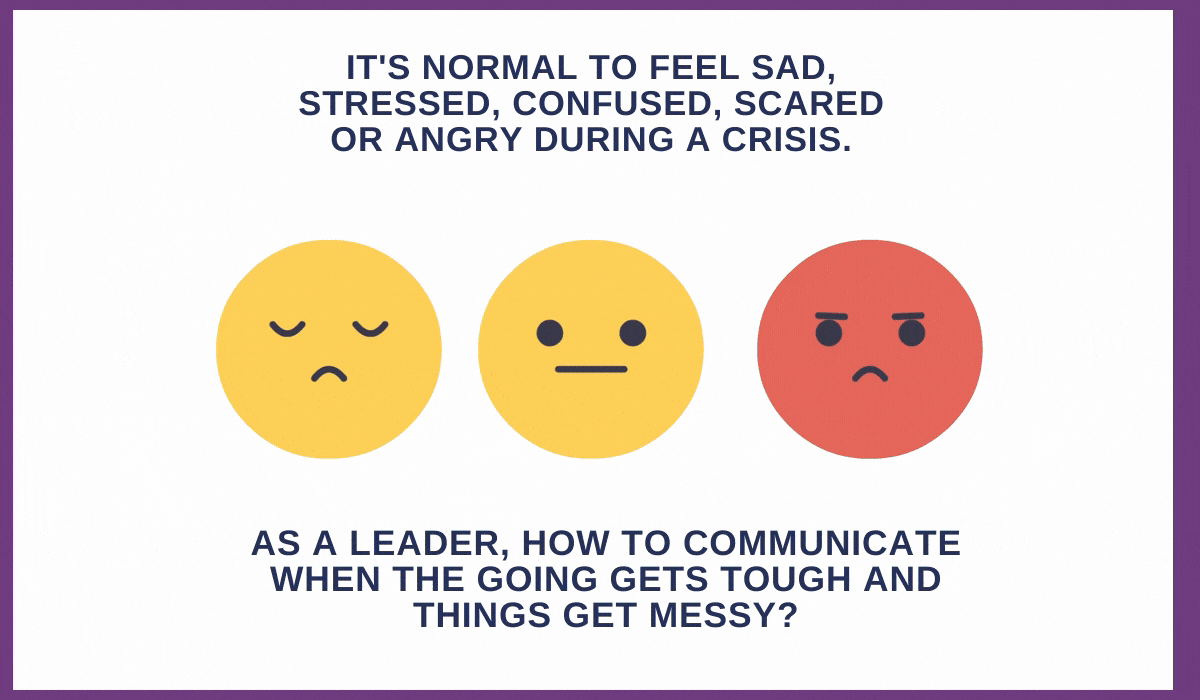The world is unpredictable and full of chaos and change. Many things can cause worry and tension in an organization. Mergers & acquisitions, leadership wrangles, controversies, and pandemics such as Covid-19 are just some of the many things that can cause a crisis within the organization.
The true test of leadership occurs when the going gets tough. How you handle yourself and communicate with your team during tough times is what determines whether your organization will rise or fall.
Thanks to the unpredictable nature of the world around us, leaders often find themselves with little time to prepare. And no excuse will ever be enough if you fail to respond in a timely manner. At the same time, you must take caution because taking the wrong approach when communicating will do more harm than good.
The infamous BP oil spill in the Gulf of Mexico is a good example of how not to respond during a crisis. Not only did millions of liters of oil spill into the sea, but also 11 crewmen lost their lives. BP’s chief executive, Tony Hayward, dealt with the disaster in the worst way possible; he shifted blame entirely to Transocean and Halliburton even before investigations had started. Investigations later revealed that BP’s gross negligence is what caused the disaster. By then, the damage had already been done with the energy giant’s credibility taking a major hit.
But look at Alan Mulally. In 2006, Ford was on the verge of declaring bankruptcy when Bill Ford brought Mullaly on board. He brought the company back to profitability, and not only that, Ford weathered the 2008-2009 depression without much turbulence. Alan Mulally accomplished this using clear communication and one slogan that echoed through the entire organization, “One Team.”

The above examples show the tremendous impact of a leader’s words and actions during a crisis. To help you navigate those murky waters of uncertainty that every crisis brings along with it, consider utilizing the following guidelines to communicate during a crisis.
1. Absorb Emotions. Do Not Amplify Them
Fear, stress, and other emotions usually run high during any crisis. As a result, chaos can ensue. As a leader, the first step you can take is to manage your own emotions. Your employees look to you for reassurance. If you project fear, they will notice it and can panic. Once you learn to observe your emotions, you can reassure your team. This will help you calm the brewing storm of emotions, and not amplify the emotions of others.
Each human being acts like a tuning fork. Every emotion is like a wave, which when reaches others, either accentuates or dies down depending on whether the frequencies match or not. When we learn to master our own emotions, it will dampen any emotional waves and allows collaboration, even in the face of disagreement. We can strengthen our relationships with others, even in the most stressful and difficult situations.
Listen to People’s Concerns & Understand Them
Be human and embrace the emotions that everyone is experiencing in moments of crisis. You will also need to be transparent about how the situation is affecting you. Opening up, sharing, and displaying vulnerability on such occasions is important, as it can help you build trust. People appreciate knowing that no one is having it easier.
Try to connect with them by asking people how they are feeling. This will not only provide an outlet for venting emotions but will also provide you with rich feedback to consider while working on a solution. It is much more effective than simply asking how they are doing.
As much as possible, try to have this meeting in a setting where you both can see each other (and not over email or chat). This is another key element of trust-building, as it shows that you care enough to address them in person. If you cannot be in the same space, set up a meeting via video call.
You will find that communication is usually better when you can read a person’s emotions through their body language and facial expressions. This is because their subconscious feedback will allow you to adapt your message and tone to soothe their anxiety.
Be Calm. Don’t React
During the heat of the moment, some folks might get too emotional. But you cannot control the feelings of another human being. Therefore, allow them to express themselves freely despite your urge to jump in. Calmness is one of the best ways of showing that you are in control of a situation.
Look at Things from Others’ Point of View
Putting yourself in the shoes of others will allow you to see things from their point of view. After listening to what someone has to say, suppress the urge to start providing solutions immediately. Instead, bring attention to their (and any shared) values and feelings. At times, this might be all you need to do to reassure your team.
However, you might need to do more. For example, ask deeper questions to encourage more active participation. This is also a great way of empowering your team, especially during a crisis, when they are more than likely feeling powerless.

2. Show People They Matter
During a crisis, you will need to communicate with your teams more often than is the norm. Frequent communication shows your people that they are on top of your priorities, and this goes a long way in reducing their fear and uncertainty.
This means that you might have to repeat your core message several times. While it might feel tiring, you have to remember that people under stress need constant reassuring.
While at it, ensure that your staff has channels through which they can contact you. Regardless of how many times you call or visit them, if the interactions only occur when you choose to, you risk missing out on all incoming communication. Providing them with a channel through which they can reach you directly allows them to know that their feedback matters to you.
Keep emphasizing how you want to hear from them, regardless of their level. This will go a long way in building the trust you will need when it comes to implementing any change you might want to implement.
The feedback channel should not be for show; make sure that you listen to what people are expressing. Therefore, you will need to respond to their feedback periodically.
Show Care for People by Taking Care of What They Care About
The biggest concern people have during a crisis is whether they will still have a job. While being reassuring is important, it is crucial that you are honest. If part of the solution will involve some people being laid off, the best course of action is to deliver the message as soon as possible.
Remember, there is no good time to deliver bad news. The sooner, the better. It allows people to start planning early. Even if you have to break the bad news about layoffs, you can help to soften the blow by choosing an outplacement vendor to help employees with the transition.
How AirBnB’s CEO Brian Chesky delivered the announcement that the company would have to make layoffs following Covid-19 restrictions is one of the best examples of how to deliver such news.
Do What is Required to Take Care of People’s Physical and Mental Well Being
The mental well-being of your employees should also be among your top considerations. During stressful times, people become more susceptible to mental health issues. Try to take care of that by providing them with resources or tools to support them. Address the issue during your meetings and let them know that the company is there for anyone who might be experiencing mental health issues.
Highlight Togetherness, and Tell People They Matter
During trying moments when stability is elusive, it is important to highlight togetherness. Let your people know that the only way to overcome the situation is by maintaining solidarity with each other. The best way of passing this message across is by reinforcing the company’s core values.
Base your message around statements or questions such as:
- Who are we as a company?
- What are our values?
- What do we believe in?
- What is our purpose?
Let your people know that their work matters. People get enormous pride and motivation, knowing that their work is not only appreciated but also contributes to the greater good. Tell people that we are in this together, and you will not be left behind.
Praise People for Holding up in Adversity, and Ask Them to Look for the Good and Lessons from the Crisis
People feel good when they are seen, heard, and their effort acknowledged. Do not underestimate the value of positive feedback, as it goes a long way in boosting an individual’s morale and productivity. It also allows them to feel like they are part of a team, thus boosting trust and loyalty within your workforce.
Therefore, even though you might have a lot on your plate, make sure that you address and acknowledge the hard times that your people have been going through. Acknowledge their ability to adapt, in addition to praising any accomplishments they might have had during the crisis.
This lets your teams know that you care about them as individuals. Additionally, ask them to take lessons from the crisis, as it will only make them better – as human beings and at work.

3. Give Hope for the Future
Keep in mind that your staff might be under tremendous pressure or anxiety due to the uncertainty of the crisis. As a leader, one of your main objectives is to give them hope and see the light at the end of the tunnel.
Show (or Create) a Plan to Remove Confusion
Remember, you are in charge. Therefore, take charge and evaluate your options. It is important that you take action as soon as possible. Indecisiveness will only breed anxiety and can lead to people questioning your leadership. Therefore, create a plan and explain how things are going to be, as soon as possible.
However, make sure that you explain your decisions. People might not like or agree with all that you have decided, but they will appreciate that you have taken it upon yourself to explain your decisions. Explain the various courses of action that you considered, and why you decided that this particular one was the most appropriate choice.
Make sure to align your actions to the company’s core values and purpose, as that will help them feel certainty, togetherness and not confusion.
Remove Uncertainty. Go Over the Facts. Give Clarity
While sharing any information about the company’s future, be honest. Tell them all that you know while admitting that there are things you do not know. Embracing the ambiguity of the situation will allow your message to resonate with its recipients better.
Assure People by Highlighting What Steps You Have Taken to Ensure their Safety
People need to know that you have taken actual steps towards ensuring their well-being. If any, highlight them and explain how they will help your team during the tumultuous period.
Communicate with Confidence, Transparency, and a Positive Outlook for the Future
In spite of your own uncertainty, you must project confidence when speaking to your teams. Be clear about everything so that you do not leave any room for speculation while remaining optimistic about the future.
Conclusion
The true test of a leader is how they steer their ship and communicate during tough times. It might be difficult, but it is doable, as long as you are proactive, empathetic, and honest.

Trackbacks/Pingbacks